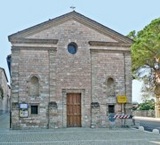
According to tradition, St Ventura Spellucci built this church on his family estate in the 12th century. He apparently belonged to the Order of Crosiers, which was dedicated to the care of pilgrims. He dedicated the church an an adjoining convent and a hospice as to Santa Croce.
When he died, St Ventura was buried in in the church. Miracles were reported at his tomb, and he seems subsequently to have been regarded as a patron saint of Spello. His presumed relics are preserved under the high altar in a sarcophagus that seems to date to the 12th century.
Soldiers damaged the complex in the 15th century. The hospice was beyond repair but the church was restored in 1625. The Order of Crosiers was suppressed in Italy in 1656, at which point the church was entrusted to the Franciscans of Sant’ Andrea.
Fausto Gentile Donnola, the author of the “Istoria della Terra di Spello” (ca. 1620), mentions that there were crosses in niches on the facade of the church, which commemorated its early history. The façade was rebuilt in 1960.
[I have yet to get inside this church, but there are a couple of illustrations in the website of the Commune.]
Madonna del Latte (13th century)
This detached fresco on the back wall was originally in the lunette above the portal of the counter-facade.
St Ventura (14th century)
This fresco is on the right wall.
Appearance of a Cross over Spello (17th century)
The inscription on this fresco is on the left wall explains the story: “The evil old woman arms with flaming swords the young men of Spello (that is, she incited discord). But they are calmed and reconciled by the illuminated cross that appeared in the sky above them”. This is a local legend of an event that happened in 1346 in the main square of the town. However, this artist shows it outside, with a lovely townscape in the background.
SS Paul and Anacletus (17th century)
This fresco is to the right of the altar wall. Pope Anacletus I (ca. 79-91 AD) is credited with the formation of the Order of Crosiers. (There is a painting (16th century) of St Anacletus founding the order in the Oratorio dei Crociferi (13th century) in Venice).
Frescoes (ca. 1625)
Two frescoes in the church are attributed to Cesare Sermei:
-
✴St Felician preaching at Spello, on the right wall; and
-
✴a miracle of the Blessed Andrew Caccioli, opposite.
Each of these is set against an interesting townscape:
-
✴St Felician preaches outside Porta Consolare; and
-
✴the Blessed Andrew revives a dead man outside Sant’ Andrea, which is depicted before the upper part of its facade was re-modeled in the late 17th century.
These frescoes were presumably commissioned shortly after the restoration of 1625, during the process for the canonisation of the Blessed Andrew in 1625-30. This was also a period in which there was a dispute in Spello as to whether the Blessed Andrew or St Felix should be named as the sole patron saint. (The campaign failed when St Felix was chosen in 1629). Corrado Fratini (referenced below) has suggested that St Felician (the patron saint of Foligno) is depicted here as the true evangelist of Spello in order to detract for the claims made for St Felix.
In the fresco of the miracle, the Blessed Andrew is identified by inscription. So too is the bearded Franciscan to the right: MORICUS DE MORICCHELLIS HISPELLA; EX CRUCIFER. This is a reference to Brother Moricus, an early companion of St Francis who had originally belonged to the Order of Crosiers and worked at their leper hospital outside Assisi. When Moricus fell ill, St Francis (who probably also worked at the hospital) sent him a remedy that cured him, after which he joined the nascent Franciscan Order.
Panel (17th century)
This panel on the left wall depicts:
-
✴[who are ?] Giacomo di Benis and Brother Bartolomeo;
-
✴Beata Cecilia and Beata Pacifica, (two nuns associated with Santa Maria di Vallegloria);
-
✴ Rubeno, who is probably the person identified as “CONREGENTE” in an inscription (1180) at San Severino; and
-
✴Bishop Epiphanius of Spello (documented in 487).






